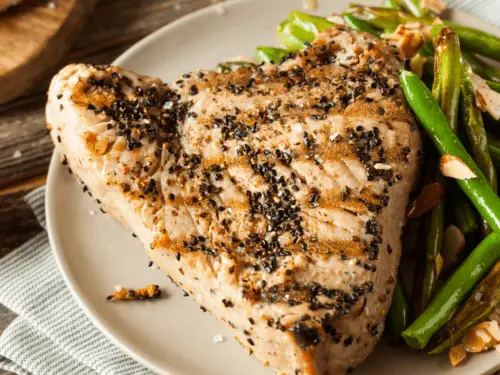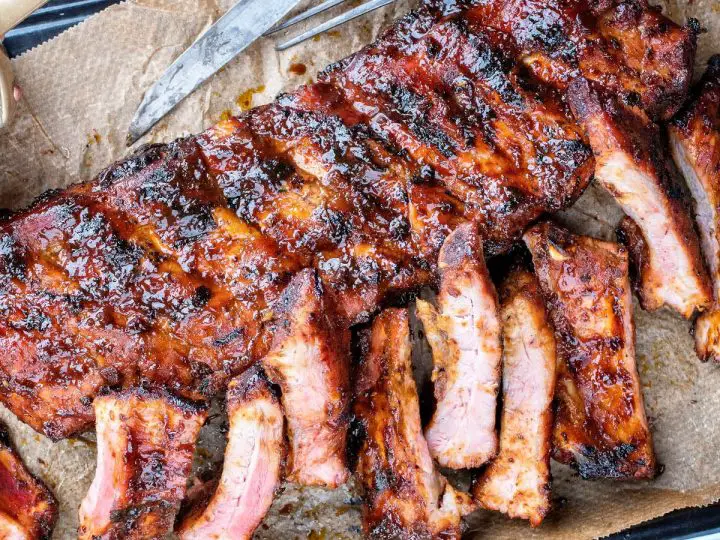Have you ever cut into a baked potato, only to find it brown on the inside? It may leave you wondering why this discoloration occurs. In this article, we will explore the reasons behind a browned baked potato and how you can prevent it from happening.
Key Takeaways:
- Overcooking, high storage temperatures, and enzymatic reactions can cause a baked potato to turn brown on the inside.
- Browning can impact the flavor, texture, and appearance of the potato, but it does not necessarily indicate spoilage.
- To prevent browning, monitor cooking times, store potatoes properly, and consider using acidic ingredients.
- If you’re concerned about the appearance, you can try peeling, using lemon juice or vinegar, or adding salt to the potato.
- Discard any potatoes that show signs of spoilage, such as a foul odor or unusual texture.
Causes of Browning in Baked Potatoes
When it comes to baked potatoes, the appearance of a browned interior can be a cause for concern. Understanding the causes of browning can help us prevent it and ensure we enjoy perfectly cooked potatoes every time.
Overcooking
One of the primary reasons for browning in baked potatoes is overcooking. When a potato is cooked for too long or at too high of a temperature, the natural sugars in the potato start to caramelize and turn brown. To avoid overcooking, it’s important to monitor the cooking time and temperature, and remove the potatoes from the oven as soon as they are cooked through.
High Storage Temperatures
Storing the potatoes at high temperatures can also lead to browning. If the potatoes are left in a warm oven or on a hot stove, the heat can cause them to brown on the inside. To prevent this, it’s best to store the potatoes in a cool, dry place, away from heat sources.
Enzymatic Reactions
Enzymatic reactions between the enzymes in the potato and the air can also contribute to browning. When the enzymes come into contact with oxygen, they can cause discoloration. While it’s not possible to completely prevent enzymatic reactions, taking steps like storing the potatoes properly and using acidic ingredients can help minimize browning.
| Cause | Explanation |
|---|---|
| Overcooking | High temperatures cause sugars to caramelize |
| High Storage Temperatures | Heat in warm environments leads to browning |
| Enzymatic Reactions | Enzymes in potato react with oxygen, causing discoloration |
Effects of Browning on Baked Potatoes
Browning on the inside of a baked potato can have several effects on its taste, texture, and visual appeal. First, the flavor of the potato may become overly sweet. This is due to the caramelization of sugars during the browning process. The natural sugars in the potato break down and create a sweeter taste, which may not be desirable for everyone.
In terms of texture, a browned potato can become softer and mushier. The prolonged exposure to heat during the browning process can cause the potato to lose some of its structure and become more tender. This change in texture may be enjoyed by some individuals, but others may prefer a firmer and fluffier potato.
Finally, the appearance of a browned potato may not be as visually appealing. The caramelized sugars and discoloration can make the potato look less appetizing. While the taste and texture may still be enjoyable, a browned potato may not be as visually appealing as a perfectly golden and evenly baked one.
| Effects of Browning on Baked Potatoes |
|---|
| Flavor becomes overly sweet |
| Texture becomes softer and mushier |
| Less visually appealing appearance |
Preventing Browning in Baked Potatoes
In order to prevent browning in baked potatoes, there are a few key steps you can take. First and foremost, it’s important to avoid overcooking the potatoes. This can be achieved by monitoring the cooking time and using a timer to ensure that the potatoes are not left in the oven for too long. Overcooking causes the natural sugars in the potatoes to caramelize, leading to browning on the inside. By cooking the potatoes just until they are tender, you can help prevent excessive browning.
Another important factor to consider is the storage temperature of the potatoes. Storing them at high temperatures can contribute to browning. It is best to store baked potatoes in a cool, dry place rather than in a warm environment. This will help to maintain their quality and reduce the likelihood of browning.
If you find yourself with leftover baked potatoes that you would like to store, refrigeration can be a useful method for preventing browning. Placing the potatoes in the refrigerator can help to slow down enzymatic reactions, which are one of the causes of browning. By keeping the potatoes chilled, you can extend their freshness and reduce the risk of discoloration.
Table: Tips for Preventing Browning in Baked Potatoes
| Tip | Description |
|---|---|
| Avoid overcooking | Monitor cooking time and use a timer to prevent excessive browning. |
| Store at cool temperatures | Keep baked potatoes in a cool, dry place to minimize browning. |
| Refrigerate leftovers | Place leftover baked potatoes in the refrigerator to slow down enzymatic reactions and prevent browning. |
By following these tips and techniques, you can ensure that your baked potatoes maintain their natural color and appeal. Preventing browning not only helps to preserve the visual appeal of the potatoes but also ensures that their flavor and texture are at their best. So, next time you bake potatoes, remember these preventive measures to achieve perfect results every time.
Other Factors Affecting Potato Browning
In addition to cooking and storage conditions, several other factors can affect potato browning. These factors include the variety of potato used, the size of the potato pieces, and the use of certain ingredients.
1. Variety of Potato
The variety of potato used can impact the browning process. Some potato varieties are more prone to browning than others. For example, russet potatoes tend to brown more easily compared to waxy potato varieties like Yukon Gold or red potatoes.
2. Size of Potato Pieces
The size of the potato pieces can also influence browning. Cutting the potato into smaller pieces before baking can increase the surface area exposed to heat and air, leading to a higher likelihood of browning. Keeping the potatoes whole or in larger chunks can help reduce browning.
3. Use of Certain Ingredients
The use of certain ingredients in the cooking process can contribute to potato browning. Acidic marinades or coatings, such as lemon juice or vinegar, can accelerate enzymatic browning. If you want to minimize browning, consider avoiding or minimizing the use of acidic ingredients in your potato recipes.
Understanding these additional factors can help you better control and prevent browning when baking potatoes. By selecting the right potato variety, adjusting the size of your potato pieces, and being mindful of the ingredients you use, you can achieve the desired level of browning in your baked potatoes.
| Factors Affecting Potato Browning | ||
|---|---|---|
| Variety of Potato | Size of Potato Pieces | Use of Certain Ingredients |
| Russet potatoes are more prone to browning compared to waxy potato varieties like Yukon Gold or red potatoes. | Cutting the potato into smaller pieces before baking can increase the likelihood of browning. | Acidic marinades or coatings, such as lemon juice or vinegar, can contribute to enzymatic browning. |
Is Brown Inside Always Bad?
When it comes to a baked potato, a brown inside may not always be visually appealing, but it doesn’t necessarily mean the potato is bad. Browning on the inside of a baked potato is primarily a result of chemical reactions and can occur even without any spoilage. However, it is important to note that if the potato has a foul odor, unusual texture, or other signs of spoilage, it is best to discard it for safety reasons.
Browning in a baked potato can be caused by various factors, including overcooking, high storage temperatures, and enzymatic reactions. Overcooking the potato can cause the natural sugars in the potato to caramelize and turn brown, resulting in a sweeter flavor. Storing the potato at high temperatures, such as in a warm oven or on a hot stove, can also lead to browning. Enzymatic reactions between the enzymes in the potato and the air can cause discoloration as well.
While a brown inside may not be visually appealing, it is important to remember that it doesn’t necessarily indicate spoilage. If you’re concerned about the appearance of a browned potato, there are a few solutions you can try. Peeling off the browned parts can help remove some of the discoloration. Using lemon juice or vinegar to brush the potato before cooking can help prevent enzymatic browning. Adding a touch of salt to the outside of the potato can also help inhibit browning.
Solutions for Discolored Baked Potatoes
If you’re faced with a baked potato that has a brown inside and you want to improve its appearance, there are a few solutions you can try. These methods can help you minimize the discoloration and achieve a more visually appealing potato.
Peeling off the Browned Parts
One option is to carefully peel off the browned parts of the potato. By removing the discolored areas, you can restore the potato’s appearance and present a more appetizing dish.
Brushing with Lemon Juice or Vinegar
Another technique is to brush the potato with lemon juice or vinegar before cooking. The acidity in these ingredients can help prevent enzymatic browning and preserve the potato’s natural color.
Adding a Touch of Salt
You may also consider adding a touch of salt to the outside of the potato. Salt can inhibit the browning process and help maintain a desirable appearance.
By utilizing these solutions, you can enhance the visual appeal of your baked potatoes and ensure a more enjoyable dining experience. Experiment with these methods to find the one that works best for you and your preferences.
| Solution | Description |
|---|---|
| Peeling off the Browned Parts | Carefully remove the discolored areas of the potato to improve its appearance. |
| Brushing with Lemon Juice or Vinegar | Apply lemon juice or vinegar to the potato before cooking to prevent enzymatic browning. |
| Adding a Touch of Salt | Incorporate a small amount of salt on the potato’s surface to inhibit the browning process. |
Conclusion
In conclusion, the brown inside of a baked potato can be attributed to various factors including overcooking, high storage temperatures, and enzymatic reactions. While the browning may affect the flavor, texture, and appearance of the potato, it doesn’t necessarily indicate spoilage.
To prevent browning, it is important to monitor cooking times and avoid overcooking the potato. Proper storage in a cool, dry place also helps to maintain the potato’s freshness and prevent discoloration. Consider using acidic ingredients like lemon juice or vinegar, as they can inhibit enzymatic browning.
If you’re concerned about the appearance of a browned potato, there are a few solutions you can try. Peeling off the browned parts can remove some of the discoloration, while brushing the potato with lemon juice or vinegar before cooking can help prevent further browning. Adding a touch of salt to the outside of the potato can also help inhibit browning.
Remember, if a potato shows signs of spoilage such as a foul odor, unusual texture, or other abnormalities, it is best to discard it. However, in most cases, a brown inside of a baked potato is simply a result of chemical reactions and can still be enjoyed without any health concerns.
FAQ
Q: Why does a baked potato turn brown on the inside?
A: A baked potato can turn brown on the inside due to overcooking, storing at high temperatures, or enzymatic reactions that occur during cooking.
Q: What causes browning in baked potatoes?
A: Browning in baked potatoes can be caused by overcooking, storing at high temperatures, and enzymatic reactions.
Q: What are the effects of browning on baked potatoes?
A: Browning can result in a sweeter flavor, softer texture, and less visually appealing appearance of the baked potato.
Q: How can I prevent browning in baked potatoes?
A: To prevent browning, monitor cooking times, store potatoes properly, and consider refrigerating leftover potatoes.
Q: What other factors can affect potato browning?
A: Factors such as potato variety, cutting into smaller pieces, and using certain ingredients can impact potato browning.
Q: Is a brown inside always an indication of spoilage?
A: No, browning on the inside of a baked potato is primarily a result of chemical reactions and doesn’t necessarily mean it is spoiled.
Q: How can I improve the appearance of a browned baked potato?
A: You can try peeling off the browned parts, brushing with lemon juice or vinegar before cooking, or adding salt to inhibit browning.


